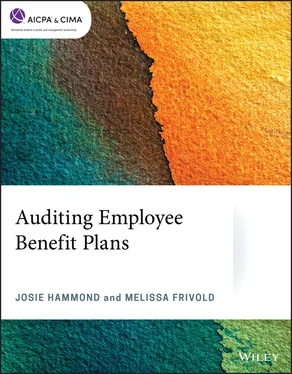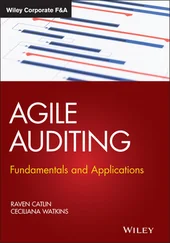These plans are subject to the normal rules for defined pension plans—actuarial calculations, mandatory funding, joint and survivor annuity distribution elections (note these plans commonly allow for lump-sum distributions), AFTAP and PBGC coverage.
The amount of controversy regarding these plans has started to fade as the courts and subsequent legislation have established some principles controlling their design and operation. Notwithstanding this added clarity, these plans and the benefit accumulations continue to be complex. As such, the auditor is advised to be particularly diligent in gaining understanding of the plan. The intricacies of these plans are beyond the scope of an introductory course and will not be discussed in the remainder of this course.
The types of welfare benefits provided have been described earlier. They cover a wide array of nonpension benefits. These plans can be separated by specific benefit type—one plan provides healthcare coverage, one plan provides disability coverage, one provides death benefits, and so on. More and more, however, employers are adopting umbrella plans. These are arrangements within which a single plan the employer provides an array of welfare benefits. Auditing such plans presents unique issues to the auditor because these umbrella plans frequently include fully insured options that would not otherwise be subject to audit but for their inclusion in an umbrella plan.
Welfare benefit plans can be separated into the categories of defined benefit and defined contribution, just like pension plans. It is most common to see defined benefit welfare plans. The plan promises to provide a certain benefit, like health coverage. Plan assets, if any, are commingled for the plan as a whole. Typically, there are no separate accounts by participants. More recently, a trend has emerged of defined contribution welfare plans in which individual participant accounts are maintained and participant benefits are limited to what is in their account. The most typical of such arrangements are medical flexible spending accounts, medical reimbursement accounts, or health savings accounts.
Unfunded, insured, or funded
Because this course is aimed at plans that are subject to audit, it is important to understand the ERISA exemptions from the financial audit for fully insured and unfunded plans. These exemptions generally apply to welfare plans because funding is voluntary for such plans.
Unfunded plans are those in which the benefits are paid entirely from employer general assets (self-insured or self-funded plans), where all benefits are covered by an insurance contract or a combination of both employer general assets and insurances. For this purpose, employee contributions are treated the same as the general assets of the employer as long as the employee contributions are used to pay benefits or premiums within the timeframe set by the ERISA regulations.
Insured plans are those arrangements in which, through the payment of premiums, the obligation to provide plan benefits has passed from the employer to the insurer.
What constitutes a funded plan is not entirely clear under ERISA. It is clear that if a trust has been established in the plan’s name, the plan is funded. This is true even if the trust has no assets. Similarly, if the plan holds assets in its name, such as a checking account, it may be considered funded. If questions arise on whether or not a plan is funded, the auditor should not make that determination. The plan or plan sponsor’s legal counsel should make that determination.
The point is that once any portion of an ERISA plan is funded, the entire plan becomes subject to the ERISA audit requirements. The audit is not limited to the funded portion of the plan, but must cover all plan activities. Further, because the plan is funded, plan assets must be held in trust and are subject to ERISA’s fiduciary conduct standards and non-exempt transaction standards with respect to such assets.
Some health care coverage arrangements involve a unique form of funding. The assets are actually held by a pension plan of the sponsor. These are referred to as 401(h) accounts, named for the tax code section that authorizes their creation. These assets must be accounted for separately within the pension plan, but they do not have to be physically segregated from the pension assets. This is an advanced topic, which is outside the scope of this program.
A cafeteria plan is a funding vehicle for a welfare benefit plan. The cafeteria plan is not a welfare benefit plan. A cafeteria plan is defined by Section 125 of the IRC. A cafeteria plan allows employees to choose between cash and certain benefits.
Two items about cafeteria plans that are important to remember include:
1 Definition of wages for any plan that uses compensation as a variable. Retirement plans are permitted to base benefit accumulations or to test for nondiscrimination based upon a compensation figure that is calculated before or after cafeteria plan employee contributions. Thus, it is important for the auditor to know whether a cafeteria plan exists and how compensation is defined in the plan.
2 Certain cafeteria plan benefits are ERISA plans. For example, a medical flexible spending account or a health savings account could be part of an ERISA plan. A dependent care flexible spending account generally would not be an ERISA plan. If the plan under audit is the employer’s health plan, depending upon the plan’s terms, the scope of the audit may include the activity of the cafeteria plan accounts.
Cafeteria plans are subject to a special rule when it comes to the requirement that plan assets be held in trust and, thus, funded. ERISA generally treats participant contributions as plan assets. Where a plan has assets, ERISA generally requires that such assets be held in trust. The current tax rules, however, require that cafeteria plan contributions be subject to a use-it-or-lose-it rule. This means that if the participant does not spend his or her cafeteria plan contribution by the end of the year, the employer gets to keep the money. These two rules are incompatible and the DOL has granted relief from the requirement to hold cafeteria plan contributions in trust. 8Similarly, the DOL has granted limited relief from the trust requirement for health savings accounts. 9
It is important to note that the IRS issued updated proposed regulations governing cafeteria plans in 2007. As of the date of this publication, these regulations had not yet been issued in final form. The IRS, however, did issue Notice 2012-40, which permits taxpayers to rely on the proposed regulations pending the publication of final regulations. The auditor is advised to watch for future amendments in client’s cafeteria plans as these regulations become final.
1 Common examples of defined contribution pension plans are which of the following?Profit-sharing plans, 401(k) plans, cash balance plans.403(b) plans, employee stock ownership plans, cafeteria plans.Cash balance plans, cafeteria plans and collectively bargained plans.Profit-sharing plans, employee stock ownership plans, 403(b) plans.
2 Which type of plan is subject to universal availability eligibility requirement?401(k).401(h).403(b).401(a).
3 If an ERISA welfare plan is considered funded, which of the following consequences results?The plan becomes subject to ERISA audit requirements.All assets must be held in a custodial account.The plan is subject to vesting and distribution notices.The plan is exempt from ERISA as long as there are sufficient funds to cover the benefit obligation.
Читать дальше











